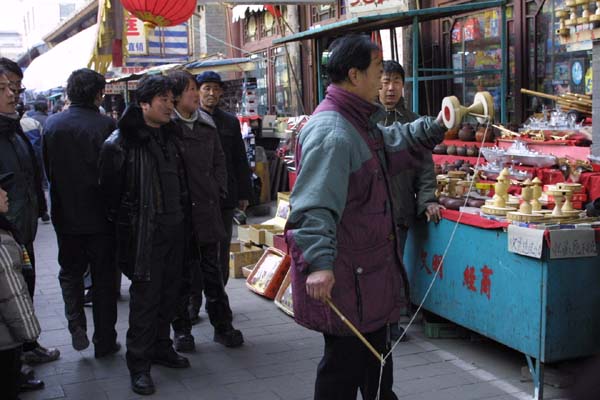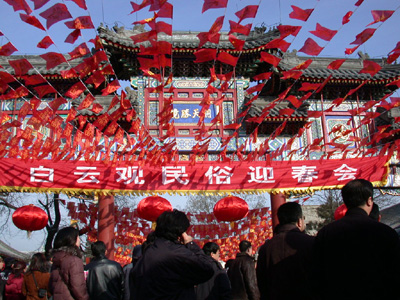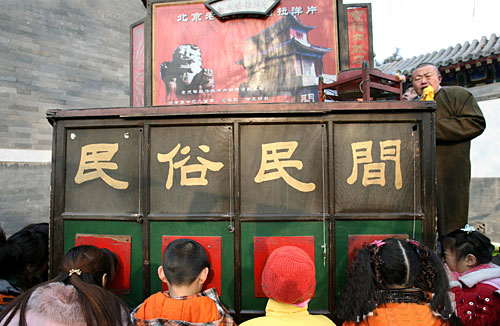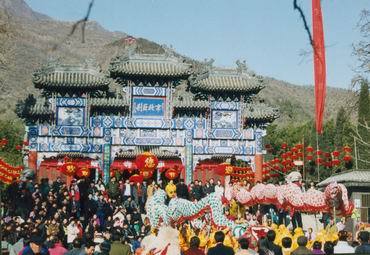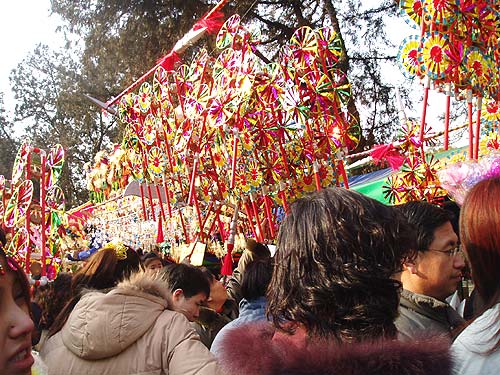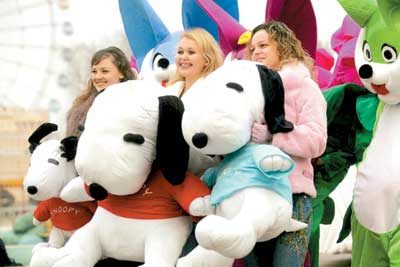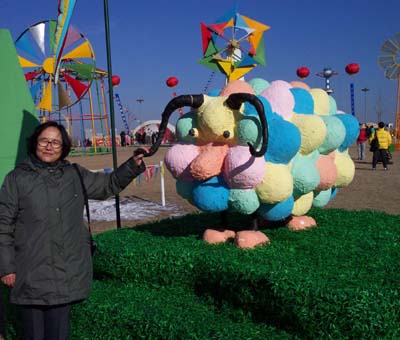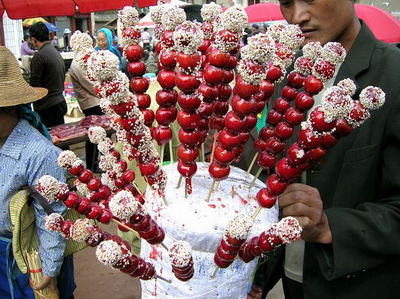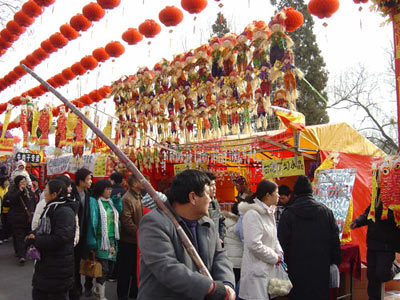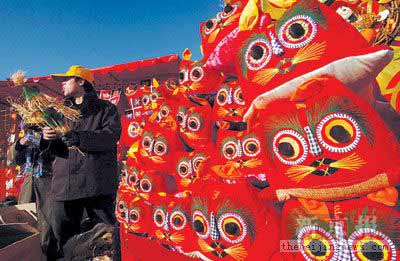| Temple Fairs |
Dates |
Venues |
Admission |
|
Ditan Temple Fair |
Feb. 6--13 |
Ditan Park |
10 yuan |
|
Longtan Temple Fair |
Feb. 6--13 |
Longtan Lake Park |
10 yuan |
|
Dongyue Temple Fair |
Feb. 6-- 12 |
Dongyue Temple |
10 yuan |
|
Changdian Temple Fair |
Feb. 7-- 12 |
Liulichang Street |
free |
|
Hongluo Temple Fair
|
Feb. 7-- 12 |
Hongluo temple |
30 yuan |
|
Honglou Temple Fair
|
Feb. 7--11 |
Daguanyuan Park |
20 yuan |
|
Lianhuachi Temple Fair |
Feb. 7--13 |
Lianhuachi Park |
6 yuan |
|
Shijingshan Temple Fair |
Feb. 7-- 13 |
Shijingshan Amusement Park |
5 yuan |
|
Chaoyang Temple Fair |
Feb. 7--12 |
Chaoyang Park |
5 yuan |
The tradition of a "temple fair" (Miao Hui) began as groups of vendors who did business near Buddhist and Taoist temples when many pilgrims came to pay tribute to the gods during traditional festivals. The practice grew, gradually turning into a regular event. Now temple fairs are an important and joyful destination for Chinese people during festivals, most especially the Spring Festival, or Chinese New Year.
Temple fairs in Beijing have a very long history, dating back to around 1000 AD, when they were called "Spring Outings," and saw a boom especially during the Ming and Qing dynasties (1368-1911) as well as the Republic of China (1912-1949). Major temples all have their own festivals, some of which are held regularly. During the Spring Festival, the temple fair is one of the most important activities, and a traditional cultural event that features all kinds of Chinese folk art. So far, there have been more than 10 major temple fairs held each year in Beijing.
In traditional temple fairs around Beijing, there are performances and booths demonstrating and selling traditional arts and crafts. The fairs have lots of games to play, food to eat, and performances to see, which attract lots of people. In the temple fairs you can taste numerous kinds of local snacks, court foods, and other dishes.
Most temple fairs feature dragon and lion dances, waist drum dancing, lotus blossom fairy dances, ground and clam dancing, as well as other folk performances, and some even stage traditional wedding ceremonies.
For foreigners, a temple fair is definitely a cultural experience, because it airs Chinese cultures from a very detailed perspective. While enjoying the samplings of Chinese delicacies, you can appreciate craftsmanship and artworks displayed by local artisans.
Nowadays, going to temple fairs has become a Spring Festival routine for residents in Beijing. This year, ten local temple fairs will add more joy to your holidays. This is the information about all temple fairs held in Beijing during the Spring Festival of 2008.
Ditan Temple Fair
Dates: February 6 -- February 13
Venue: Ditan Park, Dongcheng District
Admission: 10 yuan
To get there: Yonghegong (Lama Temple) subway, bus 13, 116 and 62 for the south gate; trolley bus 104, 108, or bus 27, 358, 119, 407, 328, 803 or 912 for the west gate. Also accessible from Andingmen subway station.
One of the city's busiest temple fairs since 1985, Ditan (Temple of Earth) Park is the site of the altar where sacrifices were formerly offered to the earth god. This year's fair will climax with a performance reenactment of a Qing Dynasty sacrificial ceremony.
The Ditan Temple Fair will feature reenactments of traditional Ming and Qing ceremonies to worship the God of Earth. The park is the site of the altar where sacrifices were once made to the God of Earth.
This fair is one of Beijing's most popular and long standing. There will also be a range of folk performances, children's puppet shows and fashion shows, art exhibitions, ice lanterns and snow sculptures, and traditional Beijing snacks.
There will be a folk culture garden featuring song and dance of western China, as well as Red Storm Ditan Rock Concert. On the south side of the Sacrificial Altar, visitors can sing karaoke.
Other activities include a folk flower fair, an acrobatic show, Quyi performances, a fashion show, and a tea serving.
Longtan Temple Fair
Dates: February 6 -- February 13
Venue: Longtan Lake Park, Zuoanmennei Dajie, Chongwen District
Admission: 10 yuan
To get there: Bus routes 807, 12, 6, 60 or 116 take you to the park
Fair events here are very similar to those in Ditan. There will be various interactive competitions inviting visitors to join in arm-wrestling, rock climbing, and chess playing. This year's temple fair in Longtanhu will also be highlighted by the "2008 Beijing Olympics" theme.
Activities including an opera show, an acrobatics show, a Quyi performance, Judo, wrestling, a table tennis competition for middle-aged and senior people, a folk diabolo-spinning competition (a game in which a two-headed top is balanced on a string held between two sticks), "World Carnival' entertainment programs for children, and delicious snacks from all over the country.
Dongyue Temple Fair
Dates: February 6 -- February 12
Venue: Dongyue Temple, Chaoyang District
Admission: 10 yuan
To get there: Bus routes 101, 109, 110, 112, 750, 846 or 813 to Shenlu Jie or 600 meters east of Chaoyangmen subway station (line 2).
Dongyue is one of the oldest temple fairs in Beijing, starting during the Yuan Dynasty and having its heyday during the Ming and Qing dynasties. The Culture of "Fu" (Good Fortune) has been the essence of this temple fair for three centuries. Performances of lion dances and Dongyue temple music will be featured this year.
Activities are including an exhibition about "Fu" culture (including a walk on a "Fu" road, hanging a "Fu" plate, circling a "Fu" tree and drawing on a "Fu" canvas), and a folk-custom show featuring various traditional folk activities. There will also be other activities, such as a Taoist music performance and a sports competition. Various artworks, books and snacks will also be available.
Changdian Temple Fair
Dates: February 7 -- February 12
Venue: Liulichang Street, Xuanwu District. From the Hepingmen intersection of South Xinhua Street, Xuwu District to the Culture Square along Hufang Road through the Hufang Bridge Intersection to the south.
Admission: Free
To get there: Bus routes 5,6, 7, 14, 15, 23, 66, 102, 105 to Hufangqiao or take subway (Line 2) to Hepingmen station.
The Changdian Temple Fair is often a favorite outing for Beijing residents during the Lunar New Year. It is a particular draw for people to buy and sell paintings and calligraphic works, antiques, articles for daily use, children's toys, food products and seasonal fruit and vegetables. In addition, acrobatics, magic shows and opera are all provided for entertainment. This temple fair is popular among foreigners.
Variety shows, cross-talk shows, traditional lion dance, stilt dance, and Dancing God of Fortune, rickshaw, and folk wedding performances will also be staged in this temple fair.
Honglou Temple Fair
Dates: February 7 -- February 11
Venue: Daguanyuan Park, Xuanwu District
Admission: 10 yuan
To get there: Bus routes 59, 19, 819, 56, 122 or 423 to Daguanyuan.
This temple fair will be held at Grand View Park, a replica of the magnificent Daguanyuan garden of an imperial family described in the well-known Chinese novel A Dream of Red Mansions by Qing Dynasty writer Cao Xueqin (17l5-l763). Besides the traditional temple fair events, there will be shows of folk arts, extreme sports, Chinese kungfu, Kaifeng Pan Drums as well as the "Two-people show" (Er Ren Zhuan) from northeastern China.
The opera Concubine Yuan Paying a Visit Home, and Amusement in Red Mansion which was adapted from the novel A Dream of Red Mansions, will also be performed. The scenes of Baoyu Getting Married and Celebrating the Lady Dowager Jia's Birthday will also be reenacted at the temple fair.
Hongluo Temple Fair
Dates: February 7 -- February 12
Venue: Hongluo Temple, Hongluo Scenic Area, Huairou County of Beijing
Admission: 30 yuan,
To get there: take Bus 916 or 936 from Dongzhimen to Huairou District and then a 10-minute taxi ride to the temple.
Hongluo Temple Fair is one of the only fairs in Beijing held in a functioning temple, and many people make the pilgrimage every year to enjoy the temples profound sense of Buddhist culture and the scenic splendor of the classical buildings.
During Spring Festival, the abbot will hold prayer meetings and give benedictions to the visitors.
For the more secular minded, there will also be folk dancing and acrobatics by Hebei Province's Cangzhou Troupe in the temple courtyard. Traditional games will also be held, such as "striking the be" and "hitting the copper cash hole." Traditional Beijing snacks are, of course, a key feature. Visitors can also see exhibitions of paintings calligraphy and photographs.
The three durable plants of winter: pine, bamboo and plum blossom add to the temple's beauty. There are also thousands of plum blossoms, including pink plum blossoms, red plum blossoms and weeping willow plum blossoms.
Lianhuachi Temple Fair
Dates: February 7 -- February 13
Venue: Lianhuachi Park
Admission: 6 yuan
To get there: Take bus routes 323, 324, 300, 368, to Liuliqiao Beili and go north for 200 meters to reach the west gate of the park.
Located close to Beijing West Railway Station, the Lotus Pond (Lianhuachi) Park is regarded as the birthplace of the city of Beijing, bearing a history of over 3,000 years. The temple fair here is quite traditional, with more than 100 events going on to make the park an ideal place to enjoy Chinese folk arts and food.
Lianhuachi Temple Fair features a special landscape of Huaguo Mountain and Shuilian Cave, the residence of the Monkey King in Journey to the West.
Other song and dance performances, such as yangge and duets of northeast China will be performed, and Shifuxian, or poem-string, an over 200-year-old folk art on the verge of extinction will make its debut at the fair.
Shijingshan Temple Fair
Dates: February 7 -- February 13
Venue: Shijingshan Amusement Park, Shijingshan District
Admission: 5 yuan
To get there: Visitors can get to the park's south gate by taking the subway to Bajiao Youleyuan. The park is 100 meters west of the subway station.
Starting from 2000, Shijingshan Temple fair is a foreign-style temple fair. It is almost like a foreign carnival parade. A cinema of 4-dimensional movies will open alongside other events this year.
Exotic performances such as a Japanese fan dance, a Korean long-drum dance , Latin dance, a Russian song and dance performance and a cartoon show will be seen on the fair. There will also be other amusement programs, including those for children.
Chaoyang Temple Fair
Dates: February 7 -- February 12
Venue: Chaoyang Park, Chaoyang District
Admission: 10 yuan
To get there: Bus routes 31, 302, 705, 731, 750, 752 or 852 to Chaoyang Park (Chaoyang Gongyuan).
Chaoyang Temple Fair is actually called, Chaoyang International Carnival. Another foreign-style temple fair in Beijing, the 2006 Changyang International Carnival will offer performances by renowned bands from the UK and Russia.
People can also go skiing, play games, and enjoy the food of various countries. This year's carnival will cooperate with local charity organizations so that people will be able to contribute to society while enjoying themselves with the diverse entertainment.
(China.org.cn January 22, 2008)

